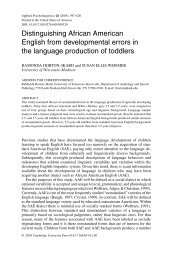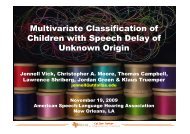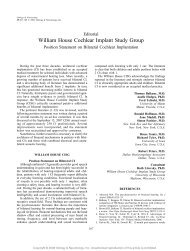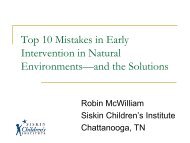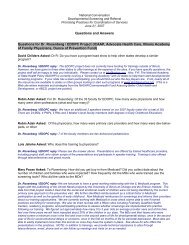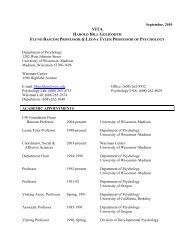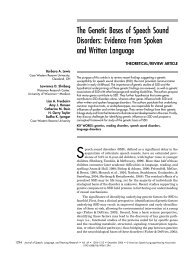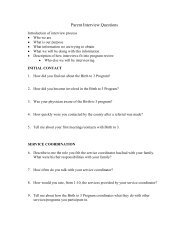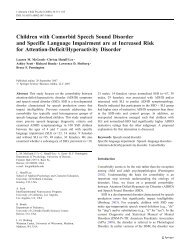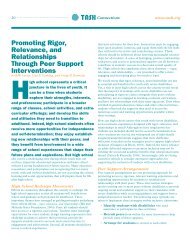Music and Language: A Developmental Comparison - Waisman ...
Music and Language: A Developmental Comparison - Waisman ...
Music and Language: A Developmental Comparison - Waisman ...
You also want an ePaper? Increase the reach of your titles
YUMPU automatically turns print PDFs into web optimized ePapers that Google loves.
<strong>Music</strong> PerceptionSpring 2004, Vol. 21, No. 3, 289–311© 2004 BY THE REGENTS OF THE UNIVERSITY OF CALIFORNIAALL RIGHTS RESERVED.<strong>Music</strong> <strong>and</strong> <strong>Language</strong>: A <strong>Developmental</strong> <strong>Comparison</strong>& JENNY R. SAFFRANERIN MC MULLENUniversity of Wisconsin-MadisonThe possible links between music <strong>and</strong> language continue to intrigue scientistsinterested in the nature of these two types of knowledge, theirevolution, <strong>and</strong> their instantiation in the brain. Here we consider music<strong>and</strong> language from a developmental perspective, focusing on the degreeto which similar mechanisms of learning <strong>and</strong> memory might subservethe acquisition of knowledge in these two domains. In particular, it seemspossible that while adult musical <strong>and</strong> linguistic processes are modularizedto some extent as separate entities, there may be similar developmentalunderpinnings in both domains, suggesting that modularity isemergent rather than present at the beginning of life. Directions for futureresearch are considered.ON the surface, music <strong>and</strong> language are wildly different. No listenerwould ever confuse a Beethoven sonata with a political speech. Bythe time we reach adulthood, we possess vast <strong>and</strong> distinct arrays of knowledgeabout each of these domains. However, from the perspective of a naïvelistener such as an infant, the two systems may not seem quite so different.The purpose of this article is to consider the learning processes facing infantsas they are confronted with their native musical <strong>and</strong> linguistic systems,<strong>and</strong> to examine the extent to which the developmental trajectories oflinguistic <strong>and</strong> musical skills may rest upon the same learning capacities, atleast early in life. In some cases, a single mechanism might underlie learningin both domains. In other cases, distinct mechanisms might be required,given the nature of the learning tasks confronting the child in each domain.It is common for scholars in cognitive science <strong>and</strong> cognitive neuroscienceinterested in music to draw comparisons with language. Why is languagethe domain most likely to be considered as a contrast to music? Unlikeother universal domains of human expertise such as vision or social organization,both music <strong>and</strong> language (included signed languages) are orga-Address correspondence to Jenny R. Saffran, Department of Psychology, University ofWisconsin-Madison, Madison, WI 53706. (e-mail: jsaffran@wisc.edu)ISSN: 0730-7829. Send requests for permission to reprint to Rights <strong>and</strong> Permissions,University of California Press, 2000 Center St., Ste. 303, Berkeley, CA 94704-1223.289
290 Erin McMullen & Jenny R. Saffrannized temporally, with the relevant structures unfolding in time. Furthermore,spoken languages, like music, reach our perceptual system as frequencyspectra, arrayed as pitches. In both cases, some of the pertinentsystematicities are universal, whereas others are culturally specific. For instance,all languages consist of phonemes, <strong>and</strong> all musical systems consistof notes; however, the specific sets thereof will vary from culture to culture.Such comparisons are necessarily limited when one considers the kindsof information communicated by music versus language; it is evident thatthe communicative uses of the two domains are vastly different. However,from the perspective of the youngest listeners, who must learn about eachsystem before discovering its communicative intent, the similarities betweenmusic <strong>and</strong> language may be heightened. This is particularly true when onedistinguishes between competence-knowledge about one’s native linguisticor musical system-<strong>and</strong> performance-one’s ability to use this knowledge communicatively,which is affected by many other factors. The difference betweencomprehension <strong>and</strong> production is particularly evident in the earlystages of first language acquisition; parents are keenly aware that theirinfants underst<strong>and</strong> far more than they can produce throughout infancy<strong>and</strong> early childhood. From this perspective, considerations of music focusnot on skilled performance as a function of organized music lessons, but onthe knowledge of music gained implicitly from the musical exposure that isubiquitous in children’s lives. As with language, this process involves inducingstructure from environmental input. Learning, combined with inherentperceptual <strong>and</strong> cognitive predispositions, eventually renders adultknowledge in each domain.Another reason for interest in comparisons between language <strong>and</strong> musicis the broader theoretical issue of modularity of mind: to what extent arecognitive processes specifically tied to particular domains? In other words,is there a neural system underlying music that is either somewhat or entirelydistinct from the neural system underlying language? Modularity is acentral theoretical construct in cognitive science, <strong>and</strong> differentconceptualizations of modularity suggest different possible relationshipsbetween language <strong>and</strong> music. Fodor’s (1983) classic formulation of modularitysuggests that distinct architectural brain regions might subserve language<strong>and</strong> music, <strong>and</strong> that these regions are informationally encapsulatedsuch that there is no cross-talk between them. On this view, the hardware<strong>and</strong> software underlying processing in each area are distinct. Peretz <strong>and</strong>Coltheart (2003) present evidence from neurologically impaired adults tosupport such a division, suggesting that the neural faculties subserving musicare quite distinct from other processes in the brain.Granting for the moment that some anatomical distinction between music<strong>and</strong> language may well exist in adults, it remains unclear whether we beginlife with this neural specialization or whether it emerges as a function of
Learning <strong>Music</strong> <strong>and</strong> <strong>Language</strong>291experience with the two domains as distinct from one another. Althoughdiscussions of modularity are often confounded with assumptions aboutinnateness, Karmiloff-Smith <strong>and</strong> others have pointed out that modularity<strong>and</strong> innateness of specific mental capacities are not inextricably linked(Elman et al., 1996; Karmiloff-Smith, 1992). Furthermore, as Elman <strong>and</strong>colleagues (1996) argue, the sheer quantity of genetic material that wouldbe required to directly encode specific modules for higher cognition is quiteunwieldy. Finally, although a specific module for language perception <strong>and</strong>comprehension would have plausible sexual selection advantages, the directbenefits of a music module are less obvious (but see Huron, 2003;Trehub, 2003). The modularity question remains an open <strong>and</strong> vexing issue,<strong>and</strong> significant further research is required to clarify it; some potentialavenues for such research may be suggested by the comparisons of theontogeny of music <strong>and</strong> language drawn here.What Do We LearnTHE SOUND STRUCTURE OF LANGUAGE AND MUSICFrom the perspective of learning about linguistic <strong>and</strong> musical systemsduring development, where might we expect to see overlap <strong>and</strong> divergence?Here we focus on the acquisition of tacit competence; that is, musical <strong>and</strong>linguistic knowledge, rather than the skills required to produce these systems.Both (spoken) language <strong>and</strong> music are generated from a finite set ofsounds (notes or phonemes), carved out of a larger possible set of sounds.These sounds are organized into discrete categories, facilitating representation<strong>and</strong> memory. For example, auditory events in both domains are subjectto the process of categorical perception: it is extremely difficult to discriminatebetween sounds that are part of the same category (e.g., differentversions of the syllable /ba/), whereas sounds that are equally physicallydifferent that span category boundaries are readily perceived (e.g., the switchfrom /ba/ to /pa/). Such auditory discontinuities are evident for speech soundsfrom early infancy (e.g., Eimas, Siquel<strong>and</strong>, Jusczyk, & Vigorito, 1971),<strong>and</strong> appear not to be linked to speech perception alone. Certain nonspeechstimuli that share similar auditory properties also elicit categorical perceptionin both adults <strong>and</strong> infants, such as the difference between a plucked<strong>and</strong> a bowed string (e.g., Cutting & Rosner, 1974; Jusczyk, Rosner, Cutting,Foard, & Smith, 1977). <strong>Music</strong>al materials can also be perceived categorically,even by nonmusicians; adults taught labels for musical intervals(e.g., “Here Comes the Bride” for the perfect fourth) perceive those intervalscategorically (Smith, Kemler Nelson, Grohskopf, & Appleton, 1994).Although infants have not been tested for categorical perception of musical
292 Erin McMullen & Jenny R. Saffranmaterials, the fact that they do show categorical perception for nonspeechanalogs of particular consonant contrasts created from tones suggests thatit is likely that they, too, would show categorical perception for at leastsome musically relevant auditory input (Jusczyk, Rosner, Reed, & Kennedy,1989).The auditory system helps to determine which categories are to play arole in each domain. Nonhuman species that presumably did not evolve toperceive speech appear to detect many of the same phonetic categories ashumans (e.g., Kuhl & Miller, 1975; Kuhl & Padden, 1982). Moreover,these speech categories are perceived by infants whose native languages donot use them (for review, see Aslin, Jusczyk, & Pisoni, 1998). Thus, in theabsence of experience, infants chunk auditory space into the speech soundrepertoire from which human languages sample; for example, young Japaneseinfants treat /r/ <strong>and</strong> /l/ as members of two distinct categories, unlikeJapanese adults. Similarly, infants show preferences for particular types ofmusical sounds. In particular, infants prefer consonant intervals over dissonantintervals from quite early in life (Trainor & Heinmiller, 1999; Trainor,Tsang, & Cheung, 2002; Zentner & Kagan, 1998). Some of these musicalpredispositions can also be demonstrated in nonhuman animals. For example,rhesus monkeys demonstrate octave equivalence only given tonalmaterials; atonal materials do not induce this perceptual capacity, suggestingauditory predispositions for tonality processing in nonhuman primates(Wright, Rivera, Hulse, Shyan, & Neiworth, 2000). Similarly, neurophysiologicalrecordings in rhesus monkeys <strong>and</strong> humans suggest similar neuralsignatures for consonant versus dissonant materials (Fishman, 2001).If linguistic <strong>and</strong> musical systems never varied across cultures, then thesepredispositions might be sufficient to explain how such systems are processed.However, the languages <strong>and</strong> musical systems of the world exhibitsubstantial differences. Thus, infants <strong>and</strong> young children must learn thespecific features of the systems in their environments. By 6 months of age,infants’ speech perception abilities are attuned to the vowels in their nativelanguage (Kuhl, Williams, Lacerda, Stevens, & Lindblom, 1992), suggestingthat just a few months of passive exposure to ambient speech is sufficientto shape infants’ vowel processing; extensive experience with speechproduction is not required. Similarly, infants’ consonant perception is attunedto the native language by 10 to 12 months of age (Werker & Lalonde,1988). In both cases, infants have shifted from categorizing all speech sounds,regardless of their status in the native language, to discriminating contrastsbetween native-language categories differently than nonnative languagecategories. This nonnative to native shift implicates powerful learning abilitiesthat operate implicitly during the first year of life. Somehow, infantsare able to learn which sounds mark meaningful differences in their languagebefore they have extensive access to word meanings.
Learning <strong>Music</strong> <strong>and</strong> <strong>Language</strong>293Although the precise learning mechanisms underlying the nonnative tonative shift in speech processing remain unknown, it appears that the statisticaldistributions of speech sounds in the input may play a critical role.Speech sounds that are part of the same category in a given language clustertogether in different ways than speech sounds that are part of differentcategories, <strong>and</strong> this appears to be information that is useable by learners.For example, the shift in vowel processing observed in 6-month-old infantscan be induced in nonhuman animals exposed to vowel distributions akinto those of particular languages, such as English versus Swedish (Kluender,Lotto, Holt, & Bloedel, 1998). Experiments explicitly manipulating thestatistical distributions of consonants have demonstrated that this informationaffects infants’ speech perception (Maye, Werker, & Gerken, 2002).It thus seems likely that the learning process that underlies the Japaneseinfant’s discovery that /r/ <strong>and</strong> /l/ are part of the same category is mediatedby the statistical structure of the sounds of Japanese.Some similar shifts have been observed in the domain of music, on thelevel of scale structures. In many instances, young infants show little to noeffect of Western tonal conventions on their perception of <strong>and</strong> memory formusical stimuli. Before 1 year of age, infants detect changes to a melodyirrespective of whether the new note conforms to the implied harmony ofthe original melody (8-month-olds: Trainor & Trehub, 1992) or to thediatonic context in general (9- to 11-month-olds: Trehub, Cohen, Thorpe,& Morrongiello, 1986). Similarly, 9-month-olds are able to detect deviationsfrom a st<strong>and</strong>ard melody regardless of whether the st<strong>and</strong>ard conformsto Western tonal conventions (Schellenberg & Trehub, 1999). By the timethey start school, however, Western listeners’ responses to stimuli begin toshow influences of typical Western musical structure. Four- to six-year-oldchildren detect changes in a diatonic melody more easily than in anondiatonic melody (Trehub et al., 1986). Similar performance effects ofchanged notes differing by key (at 5 years) <strong>and</strong> harmony (at 7 years) wereshown by Trainor <strong>and</strong> Trehub (1994). With 7- <strong>and</strong> 9-year-olds, pairwisediscrimination is likewise enhanced by the nontonality of at least one of themembers (Wilson, Wales, & Pattison, 1997). Scale structure has its greatesteffect on memory for melody when the stimuli contain repeated notes(Schellenberg & Trehub, 1999). These influences continue to be seenthroughout adulthood (Trainor & Trehub, 1992), though as with children,the effects are most pronounced with redundant melodies (Schellenberg &Trehub, 1999). Available correlational data on distributional properties ofWestern music (Budge, 1943; Krumhansl, 1990) indicates that statisticalinduction is a plausible mechanism for this kind of learning, as in the caseof phonemes. Notes <strong>and</strong> chords that are considered the strongest fit withinmany Western musical contexts-at the top of Krumhansl’s tonal hierarchytendto occur in music more often than other, less structurally important
294 Erin McMullen & Jenny R. Saffrannotes <strong>and</strong> chords. However, no experiments using artificial musical grammarinduction techniques have tested this hypothesis specifically, so conclusionsmust be somewhat more tentative than in the linguistic case.THE PROSODIC STRUCTURE OF LANGUAGE AND MUSICMoving beyond the segmental level (phonemes <strong>and</strong> tones), it is clear thatthe suprasegmental cues in both language <strong>and</strong> music are highly salient toinfants. These patterns of rhythm, stress, intonation, phrasing, <strong>and</strong> contourmost likely drive much of the early processing in both domains. Suchprosodic information is the first human-produced external sound sourceavailable in utero; the filtering properties of the fluid-filled reproductivesystem leave rhythmic cues intact relative to high-frequency information.Fetuses avail themselves of the incoming rhythmic patterns; again, this is aprocess of implicit, nonreinforced learning. For example, newborn infantsprefer their mother’s voice on the basis of prenatal learning (DeCasper &Fifer, 1980). Fetal learning also encompasses the rhythmic patterns of themother’s native language, allowing newborn infants to use this experienceto differentiate between languages (Mehler et al., 1988). It is likely thatinfants acquire specific information about musical rhythmic informationin their prenatal environments as well, assuming sufficient exposure <strong>and</strong>quality of auditory input (maternal singing is presumably the best sourceof such input).After birth, infants continue to be attuned to prosodic information inboth domains. This may be in part due to learning in the womb. It is alsolikely a function of the richness of the prosodic structure in the infants’environments. Both linguistic <strong>and</strong> musical input are modified by caregiversin ways that appear to be maximally attractive to infants. Infant-directedspeech, in comparison to adult-directed speech, is characterized cross-linguisticallyby a slower rate of speech, higher fundamental frequency, greaterrange of pitch variation, longer pauses, <strong>and</strong> characteristic repetitive intonationcontours (Fernald, 1992). Other modifications also might enhanceearly learning; for example, vowels in infant-directed speech are producedin a more extreme manner, resulting in heightened distinctiveness betweenvowel categories (Kuhl, Andruski, Chistovich, & Chistovich, 1997). Infant-directedspeech captures infants’ attention more readily than adultdirectedspeech (Cooper & Aslin, 1990; Fernald, 1985). Moreover, learningappears to be facilitated by the exaggerated prosodic contours ofinfant-directed speech; infants detect word boundaries in fluent speech morereadily when the same items are spoken with infant-directed prosody asopposed to adult-directed prosody (Thiessen, Hill, & Saffran, 2004).Caregivers also engage musically with their infants in ways that differfrom adult-directed music. The play-songs <strong>and</strong> lullabies that dominate in-
Learning <strong>Music</strong> <strong>and</strong> <strong>Language</strong>295fant-directed music share features cross-culturally, including simple, repeatedpitch contours (e.g., Trehub & Trainor, 1998). This is sensible, as contouris one of the first aspects of music to be discriminated by infants (Trehub,2003). Interestingly, renditions of caregivers’ songs tend to be sung at thesame pitch; when a given mother is recorded singing a particular song ondifferent days, she will tend to use the same key <strong>and</strong> absolute pitches(Bergeson & Trehub, 2002). As with infant-directed speech, these songsare preferred by infants from early in life (e.g., Masataka, 1999; Trainor,1996). In both domains, the affective properties of the infant-directed registerappear to be central; before the availability of other forms of communication,the prosodic contours in these two domains are a primary meansof transmitting emotional information (for a recent review, see Trehub,2003).Prosodic cues may also play a role in delineating the structural informationthat infants must learn to process in language <strong>and</strong> music. Prosodiccues are probabilistically correlated with structural boundaries such asclausal <strong>and</strong> phrasal units; for example, ends of clauses in speech are markedby syllable lengthening <strong>and</strong> a drop in pitch. The preferential listening methodologyhas been used assess the degree to which infants are aware of thesecorrelations. By 7 months of age, infants listen longer to speech samples inwhich pauses fall at clause boundaries than to speech samples in whichpauses are placed clause-internally (Hirsh-Pasek, Kemler Nelson, Jusczyk,& Cassidy, 1987). Interestingly, this is only the case when the speech samplesare derived from infant-directed speech; the more muted prosodic structureof adult-directed speech does not facilitate the detection of structuralboundaries by infants (Kemler Nelson, Jusczyk, Hirsh-Pasek, & Cassidy,1989). The results of these <strong>and</strong> similar experiments (see Jusczyk, 1997, fora review) suggest that infants detected whether or not the pauses matchedwith the other prosodic boundary markers in the speech. Similar resultsemerge from studies using musical materials (Mozart minuets); infants listenlonger to musical passages where pauses are placed at the ends of phrasesrather than in the middles of phrases (Jusczyk & Krumhansl, 1993;Krumhansl & Jusczyk, 1990). Analysis of the musical materials suggeststhat the same prosodic markers function at musical phrase boundaries asobserved with linguistic materials: a decline in pitch <strong>and</strong> a lengthening ofthe final note. It remains an open question whether infants are using thesame mechanism to detect these parallel cues across domains, or whetherinstead they have learned about these similar prosodic properties independently.Linguistic prosody <strong>and</strong> musical structure within a given culture may alsorelate in a more specific fashion. It is known that languages vary in theiroverall patterns of prosodic stress. Similarly, certain nationalistic styles ofmusic are distinguished by their usage of certain characteristic rhythmic
296 Erin McMullen & Jenny R. Saffranthemes. Might the stress patterns of one’s native language influence acomposer’s style, even for instrumental works? Patel <strong>and</strong> Daniele (2003)performed a quantitative analysis of a small corpus of nationalistic musicfrom Britain <strong>and</strong> France, two countries whose natives speak languages thatare rhythmically quite distinct; British English tends to have a high degreeof syllable-to-syllable variability in syllable length, whereas French syllablesare somewhat more evenly timed. Using a measure of rhythmic variabilityfirst developed for language, the authors discovered that British <strong>and</strong> Frenchmusic differ in much the same manner <strong>and</strong> direction as do British <strong>and</strong> Frenchspeech. Although the study compared only a strictly delimited set of samplestaken from two cultures, the methodology is quite interesting <strong>and</strong> pavesthe way for future empirical comparisons of speech <strong>and</strong> music.THE GRAMMATICAL STRUCTURE OF LANGUAGE AND MUSICAs important as segmental <strong>and</strong> suprasegmental cues are for learning bothmusical <strong>and</strong> linguistic systems, the real power of these systems comes fromtheir infinitely combinatorial nature. Both types of systems contain a wealthof culture-specific, nuanced rules for well-formed strings that must be learnedbefore adult-level comprehension can occur (Chomsky, 1957; Lerdahl &Jackendoff, 1983). Although detecting the statistical distributions of soundsaffords clear benefits to those engaged in learning surface properties of alinguistic or musical system, it has been less obvious how one might usesimilar statistical information to learn abstract grammatical rules aboutwhat to do with concrete nouns or seventh chords. Indeed, for many years,the dominant theoretical position in linguistic theory has been that infantscome prewired with a “universal grammar,” a dedicated linguistic systemcontaining a combination of innate knowledge <strong>and</strong> toggle switches for universalaspects of possible native languages, such as possible types of wordorder, which are set as the native language is learned (Chomsky, 1981).More recently, there has been interest in directly investigating the abilityof infants to infer grammatical structure from linguistic input. Marcus <strong>and</strong>colleagues showed that infants exposed to a corpus of short sentences followinga simple pattern (e.g., AAB) will reliably attend more to novel sentenceswhich fail to conform to the pattern (e.g., ABA), indicating that byage 7 months, humans are capable of pattern induction (Marcus, Vijayan,B<strong>and</strong>i Rao, & Vishton, 1999) . Slightly older infants have demonstratedsimilarly impressive abilities with more complex strings of individually utteredwords generated by a finite-state grammar (Gomez & Gerken, 1999).Impressive though this learning is, the artificial pauses between words makethe task an easier one than natural language learning, where the stimulusstream is unsegmented. Can infants use the output of a statistical parser toaccomplish a similar task? In a recent experiment, Saffran <strong>and</strong> Wilson (2003)
Learning <strong>Music</strong> <strong>and</strong> <strong>Language</strong>297exposed 12-month-old infants to a finite-state artificial grammar, presentedin sets of fluent sentences, where the only cues to word boundaries werestatistical. Infants were then tested with novel sentences that were eithergrammatical or ungrammatical. Importantly, the first-order transitionalprobabilities between syllables were identical for both grammatical <strong>and</strong>ungrammatical sentences. Thus, in order to succeed at this task, infantsfirst had to segment the words in the new language <strong>and</strong> then learn thepermissible orderings of these words. Nevertheless, infants showed a preferencefor grammatical over ungrammatical sentences, indicating that multilevelstatistical learning is possible in a short time frame. These results aremirrored by evidence that infants are aware of some of the aspects of thegrammatical structure of their native language early in the second year oflife (e.g., Hirsh-Pasek & Golinkoff, 1996).Our knowledge about how infants <strong>and</strong> young children learn the grammarof their native musical system is more limited, but available data indicatethat development of this knowledge is slower, emerging somewhatlater in ontogeny. We know that experienced listeners have a hierarchicalinternal representation of relevant structures within their musical idiomthat govern expectations of what is to come next (for a review, seeKrumhansl, 1990). Using a probe methodology in which subjects are askedwhich of a set of stimuli best completes a given context, Western listenerspreferentially end pieces on the tonic, less frequently on other notes in thetonic chord, still less frequently on other notes within the scale, <strong>and</strong> rarelyon notes outside the diatonic context (Krumhansl, 1990). No evidence hasyet been provided that infants use similar information in responding tomusical stimuli (though see Saffran, 2003b for preliminary evidence that 8-month-old infants treat tonal <strong>and</strong> atonal materials differently). However,by 5 years of age, Western children show some knowledge of Western tonalstructure (Trehub et al., 1986), <strong>and</strong> by 7 years this knowledge is comparableto an adult’s (Speer & Meeks, 1988). The reason for the slower paceof this type of grammar acquisition is unclear. Two possibilities are that (1)infants are exposed to fewer examples of musical phrases than linguisticones (which seems likely, though this has not been shown quantitatively),<strong>and</strong> (2) the practical communicative benefits of knowledge about tonalstructure are fewer than the benefits of structural linguistic knowledge.Advances in neuroscientific techniques have contributed to our underst<strong>and</strong>ingof syntactic processing in both domains (for a recent review ofthese techniques, see Tervaniemi & van Zuijen, 1999). Usingelectroencephalography (EEG), Osterhout <strong>and</strong> Holcomb (1992, 1993) foundthat words that are difficult to integrate into their surrounding sentenceselicit a positive brain potential 600 ms after their onset. This P600 component(also referred to as the syntactic positive shift, or SPS) appears to beinsensitive to other errors, such as semantically inappropriate word substi-
298 Erin McMullen & Jenny R. Saffrantutions. In an exciting extension of this line of research, Patel, Gibson,Ratner, Besson, & Holcomb (1998) showed that a comparable P600 responseis elicited by unexpected musical events. In this study, subjects heardsix kinds of stimuli: sentences containing target words that were easy, difficult,or impossible to integrate meaningfully, <strong>and</strong> chord sequences containingtarget chords that were in the key, in a nearby key, <strong>and</strong> in a distantkey. P600 responses emerged for all four types of anomalies, with largerpeaks corresponding to more severe integration difficulty. Moreover, theresponses were quite similar for speech <strong>and</strong> music stimuli of comparabledifficulty. Others have found further similarities in early neural processingof linguistic <strong>and</strong> musical syntax, both of which make use of Broca’s area<strong>and</strong> its right-hemisphere homologue. In particular, syntactically incongruouswords <strong>and</strong> out-of-key chords tend to elicit an early negative component,stronger on the left in response to speech stimuli (ELAN: Hahne &Friederici, 1999) <strong>and</strong> on the right for musical stimuli (ERAN: Koelsch,Gunter, Friederici, & Schröger, 2000; Maess, Koelsch, Gunter, & Friederici,2001). Importantly, this response has been demonstrated in nonmusicians,indicating that explicit training is not necessary for this level of implicitknowledge to develop.Meaning in <strong>Language</strong> <strong>and</strong> <strong>Music</strong>Although lower-level parallels between music <strong>and</strong> spoken language arerelatively easy to discern, the relationship between the two at the level ofsemantics is less obvious <strong>and</strong> is likely where the systems diverge moststrongly. Certainly a sonata does not carry referential meaning in the sameway that a sonnet does. However, music can <strong>and</strong> does often elicit strong,predictable emotional responses from people who may vary by culture.The nature of these mappings from sound to response, <strong>and</strong> the means oftheir construction, is of interest to the cognitive scientist; thus a comparisonof the two “meaning-systems,” loosely defined, may be instructive.In the case of music, the “meaning” that adult listeners give to phrases ismost strongly related to the emotional responses they generate. We knowthat one of the basic building blocks for this is present from early infancy;several studies have found that infants as young as 2 months old, like adults,prefer consonance to dissonance (Trainor & Heinmiller, 1999; Trainor, Wu,Tsang, & Plantinga, 2002; Zentner & Kagan, 1998). This preference haslong been posited as an important underpinning of emotion in music (e.g.,Helmholtz, 1895). In addition, research has demonstrated infant preferencesfor higher-pitched music (Trainor & Zacharias, 1998), which oftencorrelates with positive emotional judgments (e.g., Juslin & Laukka, 2003).Furthermore, as with lullabies (Trehub, Unyk, & Trainor, 1993a, 1993b),
Learning <strong>Music</strong> <strong>and</strong> <strong>Language</strong>299some emotional content in music is recognizable cross-culturally (Balkwill& Thompson, 1999), indicating a possible set of musical universals ofemotion (for a detailed review, see Juslin & Laukka, 2003).However, adult responses to specific pieces of music are complex <strong>and</strong>most likely influenced by a variety of other factors as well. For instance,many adults report having strong physiological reactions to certain musicalpieces <strong>and</strong> to particular sections within them, including tears, heartacceleration, <strong>and</strong> “chills” or “shivers down the spine” (Sloboda, 1991).These emotional responses are differentiable physiologically (Nyklícek,Thayer, & Van Doornen, 1997) <strong>and</strong> electrocortically (Schmidt & Trainor,2001), <strong>and</strong>, in the case of the “chills” reaction, are linked to increasedblood-flow in brain regions associated with emotion, motivation, <strong>and</strong>arousal (Blood & Zatorre, 2001). One oft-cited explanation for emotionalresponses to music is that listeners are experiencing alternating tension <strong>and</strong>relaxation in response to violation <strong>and</strong> confirmation of expectations (Meyer,1956). As discussed earlier, at least some of these expectations must beculturally defined <strong>and</strong> are thus learned. In addition, emotional responses inadults may result from cultural associations with particular musical gestures.An example of this is the tendency for Western listeners to associatethe major mode with happiness <strong>and</strong> the minor mode with sadness. Althoughthis distinction is reliable in adults (Crowder, 1985) <strong>and</strong> children asyoung as 3 years old (Kastner & Crowder, 1990), 6-month-old infants failto show a preference for either (Crowder, Reznick, & Rosenkrantz, 1991).In addition, in one study investigating affective associations of pieces ofmusic, Nawrot (2003) found that infants looked longer at happy faces duringthe presentation of music judged “happy” by adults, but did not looklonger at sad faces while music judged to be “sad” played. Whether thesenull results imply that infants cannot make these fine distinctions or merelythat infants of this age have not yet learned the cultural associations of themodes, remains unclear.What is the best parallel for this kind of meaning-building in the domainof language? Obviously, at the lexical level, no good correlate exists. However,human utterances carry meaning not only lexically, but alsoparalinguistically, through the use of intonation; it is here that we may finduseful comparisons. As discussed earlier, a good deal of research exists pertainingto the exaggerated prosodic contours characteristic of infant-directedspeech. In addition to cognitive <strong>and</strong> attentive benefits, some havesuggested that a major function of infant-directed speech is emotional communication<strong>and</strong> bonding. Acoustic data showing few differences betweeninfant-directed speech <strong>and</strong> emotional adult-directed speech lend support tothis idea (Trainor, Austin, & Desjardins, 2000). One could easily make asimilar argument for infant-directed music; certainly, some characteristicspertain to both, particularly infants’ preference for higher pitched (happier,
300 Erin McMullen & Jenny R. Saffranfriendlier) utterances. However, whereas these infant responses toparalinguistic features are presumed to access some universals of humanemotion, many complex adult responses to music would appear to requireenculturation. Is there a useful linguistic parallel for this level of emotionalcommunication? Perhaps a good place to look for such a link would bepoetry, which, like music, makes use of basic prosodic cues but requirescultural <strong>and</strong> syntactic knowledge for full appreciation. Some theoreticalwork has been done comparing music <strong>and</strong> poetry as abstract cognitive domains(Lerdahl, 2003), but to our knowledge, no research has contrastedthe ways in which they access emotion or the ways in which these emotionalcues become available to developing children.A final note on emotional meaning in music <strong>and</strong> speech: Recentneuroimaging work indicates that responses to nonlinguistic human vocalsounds are strongest in the right superior temporal area (Belin, Zatorre, &Ahad, 2002), near areas that have been implicated in processing of musicalpitch in other studies (Zatorre, 2003). Whether this indicates a meaningfuloverlap between the two domains has yet to be seen. However, it at leastlends plausibility to accounts of musical <strong>and</strong> linguistic evolution that emphasizeemotional communication through prosody as a primary forebearof both systems.How Do We Learn It?MEMORY FOR LANGUAGE AND MUSICFor successful learning to occur, young learners must be able to representmusical experiences in memory, permitting the subsequent accumulation<strong>and</strong> manipulation of knowledge. Interestingly, infants are remarkablyadept at representing their auditory experiences in long-term memory.Jusczyk <strong>and</strong> Hohne (1997) assessed the linguistic long-term memory abilitiesof 7-month-old infants by repeatedly exposing them to brief stories.Following a 2-week retention interval, during which the infants did nothear these stories, they were tested to see whether the words from the storieswere retained in long-term memory. The infants preferred to listen to alist of words taken from the stories compared with a new list of words,suggesting that they remembered the words last heard several weeks ago.An analogous study using musical materials suggests similar abilities existin infant musical memory (Saffran, Loman, & Robertson, 2000). Infantswere exposed at home to CD recordings of Mozart piano sonata movements,played daily for 2 weeks. Following a 2-week retention interval,during which the infants did not hear these musical selections, they weretested on passages from the familiar pieces compared with novel passagesdrawn from other Mozart piano sonatas, performed by the same pianist.These infants were compared with a control group, consisting of infants
Learning <strong>Music</strong> <strong>and</strong> <strong>Language</strong>301who had never heard any of these pieces. As expected, the control groupshowed no preference for excerpts from the familiar versus the novel sonatas.However, the experimental group evidenced effects of their previousexposure to these pieces, showing a significant difference in listening preferencesto the familiar versus the novel sonatas. Subsequent experimentsdemonstrated that the infants were not merely remembering r<strong>and</strong>om snippetsof the music, but instead had represented aspects of the overall structureof the piece, with expectations regarding the placement of particularpassages (Saffran et al., 2000). These results suggest that infants’ musicalmemory may be as nuanced as their linguistic memory.Other recent studies investigating infant long-term memory for musicsimilarly suggest that infants’ auditory representations are quite detailed.For example, infants can represent more complex pieces of music, such asRavel piano compositions, in long-term memory (Ilari & Polka, 2002).Moreover, the content of infants’ memories include some extremely specificaspects of musical performances. Ten-month-olds represent acousticpatterns drawn from the specific performances with which they were previouslyfamiliarized (Palmer, Jungers, & Jusczyk, 2001). Six-month-oldinfants remember the specific tempo <strong>and</strong> timbre of music with which theyare familiarized, failing to recognize pieces when they are played at newtempos or with new timbres, although recognition is maintained when piecesare transposed to a new key (Trainor et al., 2002). It thus appears thatinfant representations are extremely specific, not affording the opportunityto generalize to include changes in tempo or timbre. This level of specificitymust change with age, as either a function of experience or development,else listeners would not be able to recognize familiar music played on differentinstruments or at different rates. It should be noted, however, thatthe ability to remember specific performance characteristics like key, tempo,<strong>and</strong> timbre is not lost completely during development (Levitin, 1994, 1996;Palmer et al., 2001; Schellenberg, Iverson, & McKinnon, 1999; Schellenberg& Trehub, 2003). The ability to encode music abstractly complements thecapacity to engage in absolute encoding.Similar shifts in specificity obtain for linguistic materials. For example,7.5-month-old infants include talker-specific cues in their representationsof spoken words; they have difficulty recognizing words when they arespoken in new voices, whereas 10.5-month-olds do not (Houston & Jusczyk,2000). However, even younger infants are able to ignore talker-specificproperties under other circumstances—in particular, infants readily exhibitvowel normalization, categorizing individual exemplars according to vowelidentity despite differences in speaker sex (Kuhl, 1979, 1983). Infants thusappear to process linguistic auditory events at multiple levels of detail simultaneously.We see similar abilities to track multiple levels of informationin the domain of pitch perception; in some tasks, infants appear totrack absolute pitches, with no evidence of relative pitch representations
302 Erin McMullen & Jenny R. Saffran(Saffran & Griepentrog, 2001), whereas slight task manipulations lead infantsto focus on relative pitch representations (Saffran, Reeck, Niehbur, &Wilson, 2004). These findings are reminiscent of results with an avian species—starlings—whocan switch from relying on absolute pitch cues tousing relative pitch cues when necessitated by the structure of the task(MacDougall-Shackleton & Hulse, 1996).More insight into the development of auditory memory is being providedby recent work using EEG with young infants. Important componentsof adult ERP responses are seen even shortly after birth (Kushnerenko,2003), including the mismatch negativity (MMN), a preattentive measureof auditory change detection that is detected when a sequence of repetitivest<strong>and</strong>ard stimuli is interrupted by an infrequent one that deviates from thest<strong>and</strong>ard on a particular criterion of interest. The apparently short durationof the memory traces leading to the MMN have made infant researchsomewhat more difficult than studies using this method with adults (Cheour,Ceponiene, et al., 2002); however, some interesting results have nonethelessbeen obtained. Cheour et al. (1998) have demonstrated that betweenthe ages of 6 months <strong>and</strong> 1 year, infants’ processing of phonemic contrastschanges, consistent with prior behavioral data. In their study, they presentedinfants with one st<strong>and</strong>ard Finnish vowel, one deviant Finnish vowel,<strong>and</strong> one deviant Estonian vowel. They found that at 6 months, infants’EEG traces display a tendency to respond more strongly when an infrequentstimulus is more acoustically distinct—in this case, the Estonianvowel—whereas by 1 year, they exhibit larger MMNs to the less-distinctbut phonemically different Finnish vowel (Cheour et al., 1998). Learningsuch contrasts is possible even in the youngest infants. Less than a weekafter birth, Finnish infants exposed to the vowel contrast /y/ versus /y/i/while sleeping showed an MMN-like response to the less frequent sound,whereas those with no exposure or unrelated exposure showed no suchresponse—indicating that newborn auditory memory is sufficient to permitthe learning of new phonetic contrasts without any possibility of consciousattention (Cheour, Martynova, et al., 2002). To our knowledge, nocomparable infant MMN research has been done involving musical stimuli.Given that the requisite MMN to pitch change is observable in young listeners,this is a fertile field for further investigation of infant memory.Learning Mechanisms for <strong>Language</strong> <strong>and</strong> <strong>Music</strong>Once learners have received sufficient exposure to musical <strong>and</strong> linguisticsystems, they must somehow derive structure across the corpus of specificexperiences represented in memory. Various types of learning mechanismshave been implicated in this process. We focus here on two such mecha-
Learning <strong>Music</strong> <strong>and</strong> <strong>Language</strong>303nisms: rules <strong>and</strong> statistics. Rules require learners to abstract away from thespecific items in their experience to discover underlying structure. The classicformulation of this process comes from Chomsky (1959), who notedthat while no listener had ever heard the sentence “Colorless green ideassleep furiously,” that sentence was nevertheless grammatical (compare itwith the ungrammatical “Furiously green sleep ideas colorless”). Similarideas have been advanced to explain certain aspects of music cognition,including expectancies <strong>and</strong> decisions about well-formedness <strong>and</strong> grouping(Lerdahl & Jackendoff, 1983; Narmour, 2000). An experimental demonstrationof this type of process is the study by Marcus et al. (1999) mentionedearlier. In this study, 7-month-old infants were exposed to sentenceslike “wo fe fe,” “ti la la,” <strong>and</strong> “bi ta ta.” They were then tested on novelsentences that followed the ABB rule, such as “ko ga ga,” versus novelsentences that violated the ABA rule, such as “ko ga ko.” The hallmark ofrule-based learning is to have abstracted away from the particular elementsin the input to recognize “grammatical” sequences that have not been heardbefore; the infants in Marcus’ study achieved this after just a few minutesof exposure.Another learning mechanism that has received growing attention is statisticallearning: detecting patterns of sounds, words, or other units in theenvironment that cue underlying structure (for a recent review, see Saffran,2003a). The environment contains massive amounts of statistical informationthat is roughly correlated with various levels of structure. For example,the probabilities with which syllables follow one another serve as cues toword boundaries; syllable sequences that recur consistently are more likelyto be words than sequences that do not (compare the likelihood that “pre”is followed by “ty” to the likelihood that “ty” is followed by “bay”, as inthe sequence “pretty baby”). These statistics are readily captured by younginfants; 8-month-olds can discover word boundaries in fluent speech, afterjust 2 minutes of exposure, based solely on the statistical properties ofsyllable sequences (e.g., Aslin, Saffran, & Newport, 1992; Saffran, Aslin,& Newport, 1996).Similar statistical learning abilities appear to be used for sequences ofmusical tones. For example, infants can discover boundaries between “tonewords” by tracking the probabilities with which particular notes occur(Saffran & Griepentrog, 2001; Saffran, Johnson, Aslin, & Newport, 1999;Saffran, 2003b). Even complex aspects of a musical system, such as thetonal hierarchy of traditional Western music, are reflected in the statisticsof the input (Budge, 1943), implying that they may be available for statisticallearning by humans or even by neural networks (Bharucha, 1991).These results suggest that at least some aspects of music <strong>and</strong> language maybe acquired via the same learning mechanism. In some ways, this is notsurprising given other facts about music <strong>and</strong> language. For example, pitch
304 Erin McMullen & Jenny R. Saffranplays a critical role in many of the world’s languages; these “tone languages”(such as M<strong>and</strong>arin, Thai, <strong>and</strong> Vietnamese) use pitch contrastively, suchthat the same syllable, spoken with a different pitch or pitch contour, hasan entirely different meaning. This use of pitch is upheld by adult users oftone languages, who are vastly more likely to maintain highly specific pitchrepresentations for words than are their counterparts who speak nontonelanguages such as English (Deutsch, 2002).ConclusionsWe conclude by returning to the issue of modularity. Although we <strong>and</strong>other researchers have drawn some perhaps interesting parallels betweenthe faculties of language <strong>and</strong> music during development, it is vital to notethat there remains a good deal of neurological evidence for cortical separationof these functions in adults, <strong>and</strong> some imaging evidence as well. It haslong been observed by clinicians that injury of the left temporal lobe oftenresults in language impairment of various kinds; in contrast, such aphasiais less often seen with damage exclusively to the right temporal lobe. Complementingthis literature, Isabel Peretz <strong>and</strong> colleagues (Peretz & Coltheart,2003) have demonstrated the existence of an acquired form of amusia—amusic-specific processing deficit—that is related to damage to the right,but not to the left, temporal lobe. Research with normal adults has oftenindicated hemispheric lateralization of these functions as well. Electro- <strong>and</strong>magnetoencephalographic data has shown canonical lateralization for earlyauditory discrimination of chords <strong>and</strong> syllables as measured by the MMN(Tervaniemi, 2001; Tervaniemi et al., 1999). A more detailed picture hasbeen given by high-spatial-resolution techniques like positron emission tomography(PET) <strong>and</strong> functional magnetic resonance imaging (fMRI), whichalso implicate greater involvement in musical <strong>and</strong> linguistic processing forright <strong>and</strong> left auditory cortex, respectively (Tervaniemi et al., 2000), possiblydue to respective right- <strong>and</strong> left-hemisphere advantages for spectral <strong>and</strong>temporal variation (Zatorre & Belin, 2001; Zatorre, Belin, & Penhune,2002). Intracerebral work with epileptic patients indicates that even thebasic tonotopic organization of auditory cortex may differ in the two hemispheres(Liégeois-Chauvel, Giraud, Badier, Marquis, & Chauvel, 2003).How can we reconcile the apparent contradiction between the neurologicaldata that suggest modularity <strong>and</strong> some of the behavior results reviewedearlier that suggest parallels between the linguistic <strong>and</strong> musical systems?One proposal, put forth by Patel (2003), is that a distinction must bemade between the processing resources used by a cognitive faculty <strong>and</strong> thecontent that the processing creates. According to this perspective, generalauditory processing mechanisms responsible for pattern analysis are in-
Learning <strong>Music</strong> <strong>and</strong> <strong>Language</strong>305volved in the perception of both speech <strong>and</strong> music. However, the vast storesof knowledge pertaining to these separate domains may be stored in separateplaces in the brain. Patel argues that when neurological patients presentwith what appear to be domain-specific deficits in speech or music, whathas actually been lost is not the processing capacity, but the knowledgerequired to engage it as a mature comprehender or producer. On this hypothesis,basic similarities between infant speech <strong>and</strong> music learning mechanismswould be expected. To test this hypothesis, Patel suggests a morecareful examination of neuropsychological patients who present with disordersapparently specific to one domain.Another way of looking at this controversy is that a distinction must bemade between the putative modularity of mechanisms used to learn in differentdomains <strong>and</strong> the evidence for modularity of functions in the maturelearner. Although the data supporting separate cortical regions subservingsome aspects of musical <strong>and</strong> linguistic processing in adults are overwhelming,it is still quite plausible that young children may bring some of thesame skills to bear on learning in each domain. The brains of young childrenare quite plastic <strong>and</strong> show a remarkable ability to reorganize in theevent of head trauma, which suggests that, whatever the arguments forfunctional localization in adults, it is not fixed in children. Furthermore,differences between the brains of musicians <strong>and</strong> nonmusicians have alreadybeen demonstrated (e.g., Schlaug, 2003), <strong>and</strong> it is tempting to concludefrom this that experience has a profound effect on cortical organization.However, this hypothesis requires further testing, perhaps through a systematicinvestigation of less experienced brains. To date, relatively few imagingstudies have been done with young children, in part because of therisks associated with PET. Luckily, with the advent of less invasive techniqueslike fMRI, it has become possible to see whether imaging resultsshowing modularity in adults can be replicated in children. Efforts in thisdirection have been aided by a recent study by Kang <strong>and</strong> colleagues, whichshowed that st<strong>and</strong>ard methodological procedures for h<strong>and</strong>ling adult fMRIdata, such as st<strong>and</strong>ardizing it to a common stereotactic space, are adequatefor working with child imaging data (Kang, Burgund, Lugar, Petersen, &Schlaggar, 2003). Early results suggest that some language-related functionsdo show age-related organizational differences that are unrelated toperformance level (Schlaggar et al., 2002). However, more detailed researchmust be done using auditory musical <strong>and</strong> linguistic stimuli in order to betterunderst<strong>and</strong> the modularity issue as it pertains to music <strong>and</strong> language.The theoretical issue of modularity aside, it is also the case that metaphorplays a powerful role in directing our thinking <strong>and</strong> suggesting newinsights. Whether or not music <strong>and</strong> language share common ancestry orcircuitry, thinking about them as related functions may still be quite helpfulin generating novel hypotheses that can help us to better underst<strong>and</strong>
306 Erin McMullen & Jenny R. Saffranthem as separate domains. It is our hope that our review of the relevantlinguistic <strong>and</strong> musical issues will help to inspire productive developmentalresearch toward this end. 1ReferencesAslin, R., Jusczyk, P., & Pisoni, D. B. (1998). Speech <strong>and</strong> auditory processing during infancy:Constraints on <strong>and</strong> precursors to language. In D. Kuhn & R. Siegler (Eds.), H<strong>and</strong>bookof Child Psychology (5th ed., Vol. 2, pp. 147–198). New York: Wiley.Aslin, R., Saffran, J., & Newport, E. (1992). Computation of conditional probability statisticsby 8-month-old infants. Psychological Science, 9, 321–324.Balkwill, L.-L., & Thompson, W. F. (1999). A cross-cultural investigation of the perceptionof emotion in music: Psychophysical <strong>and</strong> cultural cues. <strong>Music</strong> Perception, 17, 43–64.Belin, P., Zatorre, R. J., & Ahad, P. (2002). Human temporal-lobe response to vocal sounds.Cognitive Brain Research, 13, 17–26.Bergeson, T., & Trehub, S. (2002). Absolute pitch <strong>and</strong> tempo in mothers’ songs to infants.Psychological Science, 13, 72–75.Bharucha, J. (1991). Pitch, harmony, <strong>and</strong> neural nets: A psychological perspective. In P.Todd & D. G. Loy (Eds.), <strong>Music</strong> <strong>and</strong> connectionism (pp. 84–99). Cambridge, MA: MITPress.Blood, A., & Zatorre, R. J. (2001). Intensely pleasurable responses to music correlate withactivity in brain regions implicated in reward <strong>and</strong> emotion. Proceedings of the NationalAcademy of Sciences, 98, 11818–11823.Budge, H. (1943). A study of chord frequencies: Based on the music of representative composersof the eighteenth <strong>and</strong> nineteenth centuries. New York: Teachers’ College, ColumbiaUniversity.Cheour, M., Ceponiene, R., Lehtokoski, A., Luuk, A., Allik, J., Alho, K., & Näätänen, R.(1998). Development of language-specific phoneme representations in the infant brain.Nature Neuroscience, 1, 351–353.Cheour, M., Ceponiene, R., Leppänen, P., Alho, K., Kujala, T., Renlund, M., Fellman, V., &Näätänen, R. (2002). The auditory sensory memory trace decays rapidly in newborns.Sc<strong>and</strong>inavian Journal of Psychology, 43, 33–39.Cheour, M., Martynova, O., Näätänen, R., Erkkola, R., Sillanpää, M., Kero, P., Raz, A.,Kaipio, M.-L., Hiltunen, J., Aaltonen, O., Savela, J., & Hämäläinen. (2002). Speechsounds learned by sleeping newborns. Nature, 415, 599–600.Chomsky, N. (1957). Syntactic structures. The Hague: Mouton.Chomsky, N. (1959). A review of B. F. Skinner’s Verbal Behavior. <strong>Language</strong>, 35, 26–58.Chomsky, N. (1981). Lectures on government <strong>and</strong> binding. Dordrecht: Foris.Cooper, R., & Aslin, R. (1990). Preference for infant-directed speech in the first monthafter birth. Child Development, 61, 1584–1595.Crowder, R. (1985). Perception of the major/minor distinction: III. Hedonic, musical, <strong>and</strong>affective discriminations. Bulletin of the Psychonomic Society, 23, 314–316.Crowder, R., Reznick, J. S., & Rosenkrantz, S. (1991). Perception of the major/minor distinction:V. Preferences among infants. Bulletin of the Psychonomic Society, 29, 187–188.Cutting, J., & Rosner, B. (1974). Categories <strong>and</strong> boundaries in speech <strong>and</strong> music. Perception<strong>and</strong> Psychophysics, 16, 564–570.1. Preparation of this manuscript was supported by grants from NICHD (HD37466)<strong>and</strong> NSF (BCS-9983630) to JRS, <strong>and</strong> a University of Wisconsin Graduate Fellowship <strong>and</strong> aBeinecke Brothers Memorial Fellowship to EMM. We thank Erik Thiessen for helpful commentson a previous draft.
Learning <strong>Music</strong> <strong>and</strong> <strong>Language</strong>307DeCasper, A., & Fifer, W. (1980). Of human bonding: Newborns prefer their mothers’voices. Science, 208, 1174–1176.Deutsch, D. (2002). The puzzle of absolute pitch. Current Directions in Psychological Science,11, 200–204.Eimas, P., Siquel<strong>and</strong>, E., Jusczyk, P., & Vigorito, J. (1971). Speech perception in infants.Science, 171, 303–306.Elman, J., Bates, E., Johnson, E., Karmiloff-Smith, A., Parisi, D., & Plunkett, K. (1996).Rethinking innateness: A connectionist perspective on development (Vol. 10). Cambridge,MA: MIT Press.Fernald, A. (1985). Four-month-old infants prefer to listen to motherese. Infant Behavior<strong>and</strong> Development, 8, 181–195.Fernald, A. (1992). Human maternal vocalizations to infants as biologically relevant signals:An evolutionary perspective. In J. H. Barkow & L. Cosmides (Eds.), The adaptedmind: Evolutionary psychology <strong>and</strong> the generation of culture (pp. 391–428). London:Oxford University Press.Fishman, Y. (2001). Consonance <strong>and</strong> dissonance of musical chords: Neural correlates inauditory cortex of monkeys <strong>and</strong> humans. Journal of Neurophysiology, 86, 2761–2788.Fodor, J. (1983). Modularity of mind. Cambridge, MA: MIT Press.Gomez, R., & Gerken, L. (1999). Artificial grammar learning by 1-year-olds leads to specific<strong>and</strong> abstract knowledge. Cognition, 70, 109–135.Hahne, A., & Friederici, A. D. (1999). Electrophysiological evidence for two steps in syntacticanalysis: Early automatic <strong>and</strong> late controlled processes. Journal of Cognitive Neuroscience,11, 194–205.Helmholtz, H. L. F. von (1895). On the sensations of tone as a physiological basis for thetheory of music (A. J. Ellis, Trans.) (3rd ed.). London: Longmans, Green, <strong>and</strong> Co.Hirsh-Pasek, K., & Golinkoff, R. (1996). The origins of grammar: Evidence from earlylanguage comprehension. Cambridge, MA: MIT Press.Hirsh-Pasek, K., Kemler Nelson, D., Jusczyk, P., & Cassidy, K. (1987). Clauses are perceptualunits for young infants. Cognition, 26, 269–286.Houston, D., & Jusczyk, P. (2000). The role of talker-specific information in word segmentationby infants. Journal of Experimental Psychology: Human Perception <strong>and</strong> Performance,26, 1570–1582.Huron, D. (2003). Is music an evolutionary adaptation? In I. Peretz & R. J. Zatorre (Eds.),The cognitive neuroscience of music (pp. 57–75). Oxford: Oxford University Press.Ilari, B., & Polka, L. (2002). Memory for music in infancy: The role of style <strong>and</strong> complexity.Paper presented at the International Conference on Infant Studies, Toronto.Jusczyk, P. (1997). The discovery of spoken language. Cambridge, MA: MIT Press.Jusczyk, P., & Hohne, E. (1997). Infants’ memory for spoken words. Science, 277, 1984–1986.Jusczyk, P., Rosner, B., Cutting, J., Foard, C. F., & Smith, L. B. (1977). Categorical perceptionof non-speech sounds by two-month-old infants. Perception <strong>and</strong> Psychophysics, 21,50–54.Jusczyk, P., Rosner, B., Reed, M., & Kennedy, L. (1989). Could temporal order differencesunderlie 2-month-olds’ discrimination of English voicing contrasts? Journal of the AcousticalSociety of America, 85, 1741–1749.Jusczyk, P. W., & Krumhansl, C. L. (1993). Pitch <strong>and</strong> rhythmic patterns affecting infants’sensitivity to musical phrase structure. Journal of Experimental Psychology: HumanPerception <strong>and</strong> Performance, 19, 627–640.Juslin, P., & Laukka, P. (2003). Communication of emotions in vocal expression <strong>and</strong> musicperformance: Different channels, same code? Psychological Bulletin, 129, 770–814.Kang, H. C., Burgund, E. D., Lugar, H., Petersen, S., & Schlaggar, B. (2003). <strong>Comparison</strong>of functional activation foci in children <strong>and</strong> adults using a common stereotactic space.NeuroImage, 19, 16–28.Karmiloff-Smith, A. (1992). Beyond modularity: A developmental perspective on cognitivescience. Cambridge, MA: MIT Press.
308 Erin McMullen & Jenny R. SaffranKastner, M., & Crowder, R. (1990). Perception of the major/minor distinction: IV. Emotionalconnotations in young children. <strong>Music</strong> Perception, 8, 189–202.Kemler Nelson, D., Jusczyk, P., Hirsh-Pasek, K., & Cassidy, K. (1989). How the prosodiccues in motherese might assist language learning. Journal of Child <strong>Language</strong>, 16, 55–68.Kluender, K., Lotto, A., Holt, L., & Bloedel, S. (1998). Role of experience for languagespecificfunctional mappings of vowel sounds. Journal of the Acoustical Society ofAmerica, 104, 3568–3582.Koelsch, S., Gunter, T. C., Friederici, A. D., & Schröger, E. (2000). Brain indices of musicprocessing: “Nonmusicians” are musical. Journal of Cognitive Neuroscience, 12, 520–541.Krumhansl, C. L. (1990). Cognitive foundations of musical pitch (Vol. 17). New York:Oxford University Press.Krumhansl, C. L., & Jusczyk, P. W. (1990). Infants’ perception of phrase structure in music.Psychological Science, 1, 70–73.Kuhl, P. (1979). Speech perception in early infancy: Perceptual constancy for spectrallydissimilar vowel categories. Journal of the Acoustical Society of America, 66, 1668–1679.Kuhl, P. (1983). Perception of auditory equivalence classes for speech in early infancy. InfantBehavior <strong>and</strong> Development, 6, 263–285.Kuhl, P., Andruski, J., Chistovich, I., & Chistovich, L. (1997). Cross-language analysis ofphonetic units in language addressed to infants. Science, 277, 684–686.Kuhl, P., & Miller, J. (1975). Speech perception by the chinchilla: Voiced-voiceless distinctionin alveolar plosive consonants. Science, 190, 69–72.Kuhl, P., & Padden, D. (1982). Enhanced determinability at the phonetic boundaries for thevoicing feature in macacques. Perception <strong>and</strong> Psychophysics, 32, 542–550.Kuhl, P., Williams, K., Lacerda, F., Stevens, K., & Lindblom, B. (1992). Linguistic experiencealters phonetic perception in infants by 6 months of age. Science, 255, 606–608.Kushnerenko, E. (2003). Maturation of the cortical auditory event-related brain potentialsin infancy. Unpublished doctoral dissertation, University of Helsinki, Helsinki.Lerdahl, F. (2003). The sounds of poetry viewed as music. In I. Peretz & R. J. Zatorre(Eds.), The cognitive neuroscience of music. Oxford: Oxford University Press.Lerdahl, F., & Jackendoff, R. (1983). A generative theory of tonal music. Cambridge, MA:MIT Press.Levitin, D. J. (1994). Absolute memory for musical pitch: Evidence from the production oflearned melodies. Perception <strong>and</strong> Psychophysics, 56, 414–423.Levitin, D. J. (1996). Memory for musical tempo: Additional evidence that auditory memoryis absolute. Perception <strong>and</strong> Psychophysics, 58, 927–935.Liégeois-Chauvel, C., Giraud, K., Badier, J.-M., Marquis, P., & Chauvel, P. (2003). Intracerebralevoked potentials in pitch perception reveal a functional asymmetry of humanauditory cortex. In I. Peretz & R. J. Zatorre (Eds.), The cognitive neuroscience of music(pp. 3–20). Oxford: Oxford University Press.MacDougall-Shackleton, S., & Hulse, S. (1996). Concurrent absolute <strong>and</strong> relative pitchprocessing by European starlings (Sturnus vulgaris). Journal of Comparative Psychology,110, 139–146.Maess, B., Koelsch, S., Gunter, T. C., & Friederici, A. D. (2001). <strong>Music</strong>al syntax is processedin Broca’s area: An MEG study. Nature Neuroscience, 4, 540–545.Marcus, G., Vijayan, S., B<strong>and</strong>i Rao, S., & Vishton, P. M. (1999). Rule learning by sevenmonth-oldinfants. Science, 283, 77–80.Masataka, N. (1999). Preferences for infant-directed singing in 2-day-old hearing infants ofdeaf parents. <strong>Developmental</strong> Psychology, 35, 1001–1005.Maye, J., Werker, J., & Gerken, L. (2002). Infant sensitivity to distributional informationcan affect phonetic discrimination. Cognition, 82, B101–B111.Mehler, J., Jusczyk, P., Lambertz, G., Halsted, N., Bertoncini, J., & Amiel-Tison, C. (1988).A precursor of language acquisition in young infants. Cognition, 29, 143–178.Meyer, L. (1956). Emotion <strong>and</strong> meaning in music. Chicago: University of Chicago Press.
Learning <strong>Music</strong> <strong>and</strong> <strong>Language</strong>309Narmour, E. (2000). <strong>Music</strong> expectation by cognitive rule-mapping. <strong>Music</strong> Perception, 17,329–398.Nawrot, E. S. (2003). The perception of emotional expression in music: Evidence frominfants, children <strong>and</strong> adults. Psychology of <strong>Music</strong>, 31, 75–92.Nyklícek, I., Thayer, J. F., & Van Doornen, L. J. P. (1997). Cardiorespiratory differentiationof musically-induced emotions. Journal of Psychophysiology, 11, 304–321.Osterhout, L., & Holcomb, P. (1992). Event-related brain potentials elicited by syntacticanomaly. Journal of Memory <strong>and</strong> <strong>Language</strong>, 31, 785–806.Osterhout, L., & Holcomb, P. (1993). Event-related potentials <strong>and</strong> syntactic anomaly: Evidenceof anomaly detection during the perception of continuous speech. <strong>Language</strong> <strong>and</strong>Cognitive Processes, 8, 413–437.Palmer, C., Jungers, M. K., & Jusczyk, P. W. (2001). Episodic memory for musical prosody.Journal of Memory <strong>and</strong> <strong>Language</strong>, 45, 526–545.Patel, A., Gibson, E., Ratner, J., Besson, M., & Holcomb, P. (1998). Processing syntacticrelations in language <strong>and</strong> music: An event-related potential study. Journal of CognitiveNeuroscience, 10, 717–733.Patel, A. D. (2003). <strong>Language</strong>, music, syntax <strong>and</strong> the brain. Nature Neuroscience, 6, 674–681.Patel, A. D., & Daniele, J. R. (2003). An empirical comparison of rhythm in language <strong>and</strong>music. Cognition, 87, B35–B45.Peretz, I., & Coltheart, M. (2003). Modularity of music processing. Nature Neuroscience,6, 688–691.Saffran, J. R. (2003a). Statistical language learning: Mechanisms <strong>and</strong> constraints. CurrentDirections in Psychological Science, 12, 110–114.Saffran, J. R. (2003b). Absolute pitch in infancy <strong>and</strong> adulthood: The role of tonal structure.<strong>Developmental</strong> Science, 6, 35–43.Saffran, J. R., Aslin, R. N., & Newport, E. L. (1996). Statistical learning by 8-month-oldinfants. Science, 274, 1926–1928.Saffran, J. R., & Griepentrog, G. (2001). Absolute pitch in infant auditory learning: Evidencefor developmental reorganization. <strong>Developmental</strong> Psychology, 37, 74–85.Saffran, J. R., Johnson, E., Aslin, R. N., & Newport, E. L. (1999). Statistical learning oftone sequences by human infants <strong>and</strong> adults. Cognition, 70, 27–52.Saffran, J. R., Loman, M., & Robertson, R. (2000). Infant memory for musical experiences.Cognition, 77, B15–B23.Saffran, J. R., Reeck, K., Niehbur, A., & Wilson, D. (2004). Changing the tune: Absolute<strong>and</strong> relative pitch processing by adults <strong>and</strong> infants. Manuscript submitted for publication.Saffran, J. R., & Wilson, D. (2003). From syllables to syntax: Multi-level statistical learningby 12-month-old infants. Infancy, 4, 273–284.Schellenberg, E. G., Iverson, P., & McKinnon, M. (1999). Name that tune: Identifyingpopular recordings from brief excerpts. Psychonomic Bulletin & Review, 6, 641–646.Schellenberg, E. G., & Trehub, S. (1999). Culture-general <strong>and</strong> culture-specific factors inthe discrimination of melodies. Journal of Experimental Child Psychology, 74, 107–127.Schellenberg, E. G., & Trehub, S. (2003). Good pitch memory is widespread. PsychologicalScience, 14, 262–266.Schlaggar, B., Brown, T., Lugar, H., Visscher, K., Miezin, F., & Petersen, S. (2002). Functionalneuroanatomical differences between adults <strong>and</strong> school-age children in the processingof single words. Science, 296, 1476–1479.Schlaug, G. (2003). The brain of musicians. In I. Peretz & R. J. Zatorre (Eds.), The cognitiveneuroscience of music. Oxford: Oxford University Press.Schmidt, L., & Trainor, L. (2001). Frontal brain electrical activity (EEG) distinguishes valence<strong>and</strong> intensity of musical emotions. Cognition <strong>and</strong> Emotion, 15, 487–500.Sloboda, J. A. (1991). <strong>Music</strong> structure <strong>and</strong> emotional response: Some empirical findings.Psychology of <strong>Music</strong>, 19, 110–120.
310 Erin McMullen & Jenny R. SaffranSmith, L. B., Kemler Nelson, D., Grohskopf, L. A., & Appleton, T. (1994). What child isthis? What interval was that? Familiar tunes <strong>and</strong> music perception in novice listeners.Cognition, 52, 23–54.Speer, J., & Meeks, P. (1988). School children’s perception of pitch in music.Psychomusicology, 5, 49–56.Tervaniemi, M. (2001). <strong>Music</strong>al sound processing in the human brain: Evidence from electric<strong>and</strong> magnetic recordings. In R. J. Zatorre & I. Peretz (Eds.), The biological foundationsof music (Vol. 930, pp. 259–272). New York, NY: New York Academy of Sciences.Tervaniemi, M., Kujala, A., Alho, K., Virtanen, J., Ilmoniemi, R. J., & Näätänen, R. (1999).Functional specialization of the human auditory cortex in processing phonetic <strong>and</strong> musicalsounds: A magnetoencephalographic (MEG) study. NeuroImage, 9, 330–336.Tervaniemi, M., Medvedev, S. V., Alho, K., Pakhomov, S. V., Roudas, M. S., van Zuijen, T.L., & Näätänen, R. (2000). Lateralized automatic auditory processing of phonetic versusmusical information: A PET study. Human Brain Mapping, 10, 74–79.Tervaniemi, M., & van Zuijen, T. L. (1999). Methodologies of brain research in cognitivemusicology. Journal of New <strong>Music</strong> Research, 28, 200–208.Thiessen, E., Hill, E., & Saffran, J. (2004). Infant-directed speech facilitates word segmentation.Manuscript submitted for publication.Trainor, L. (1996). Infant preferences for infant-directed versus noninfant-directed playsongs<strong>and</strong> lullabies. Infant Behavior <strong>and</strong> Development, 19, 83–92.Trainor, L., Austin, C., & Desjardins, R. (2000). Is infant-directed speech prosody a resultof the vocal expression of emotion? Psychological Science, 11, 188–195.Trainor, L., & Heinmiller, B. (1999). The development of evaluative responses to music:Infants prefer to listen to consonance over dissonance. Infant Behavior <strong>and</strong> Development,21, 77–88.Trainor, L., & Trehub, S. (1992). A comparison of infants’ <strong>and</strong> adults’ sensitivity to Westernmusical structure. Journal of Experimental Psychology: Human Perception <strong>and</strong> Performance,18, 394–402.Trainor, L., & Trehub, S. (1994). Key membership <strong>and</strong> implied harmony in Western tonalmusic: <strong>Developmental</strong> perspectives. Perception <strong>and</strong> Psychophysics, 56, 125–132.Trainor, L., Wu, L., Tsang, C. D., & Plantinga, J. (2002). Long-term memory for music ininfancy. Paper presented at the International Conference on Infant Studies, Toronto.Trainor, L., & Zacharias, C. (1998). Infants prefer higher-pitched singing. Infant Behavior<strong>and</strong> Development, 21, 799–805.Trainor, L. J., Tsang, C. D., & Cheung, V. H. W. (2002). Preference for sensory consonancein 2- <strong>and</strong> 4-month-old infants. <strong>Music</strong> Perception, 20, 187–194.Trehub, S. (2003). <strong>Music</strong>al predispositions in infancy: An update. In I. Peretz & R. J. Zatorre(Eds.), The cognitive neuroscience of music (pp. 3–20). Oxford: Oxford University Press.Trehub, S., Cohen, A., Thorpe, L., & Morrongiello, B. (1986). Development of the perceptionof musical relations: Semitone <strong>and</strong> diatonic structure. Journal of Experimental Psychology:Human Perception <strong>and</strong> Performance, 12, 295–301.Trehub, S., & Trainor, L. (1998). Singing to infants: Lullabies <strong>and</strong> playsongs. Advances inInfancy Research, 12, 43–77.Trehub, S., Unyk, A., & Trainor, L. (1993a). Adults identify infant-directed music acrosscultures. Infant Behavior <strong>and</strong> Development, 16, 193–211.Trehub, S., Unyk, A., & Trainor, L. (1993b). Maternal singing in cross-cultural perspective.Infant Behavior <strong>and</strong> Development, 16, 285–295.Werker, J., & Lalonde, C. (1988). Cross-language speech perception: Initial capabilities <strong>and</strong>developmental change. <strong>Developmental</strong> Psychology, 24, 672–683.Wilson, S., Wales, R., & Pattison, P. (1997). The representation of tonality <strong>and</strong> meter inchildren aged 7 to 9. Journal of Experimental Child Psychology, 64, 42–66.Wright, A., Rivera, J., Hulse, S., Shyan, M., & Neiworth, J. (2000). <strong>Music</strong> perception <strong>and</strong>octave generalization in rhesus monkeys. Journal of Experimental Psychology: General,129, 291–307.Zatorre, R. J. (2003). Neural specializations for tonal processing. In I. Peretz & R. J. Zatorre(Eds.), The cognitive neuroscience of music (pp. 231–246). Oxford: Oxford UniversityPress.
Learning <strong>Music</strong> <strong>and</strong> <strong>Language</strong>311Zatorre, R. J., & Belin, P. (2001). Spectral <strong>and</strong> temporal processing in human auditorycortex. Cerebral Cortex, 11, 946–953.Zatorre, R. J., Belin, P., & Penhune, V. (2002). Structure <strong>and</strong> function of auditory cortex:music <strong>and</strong> speech. Trends in Cognitive Sciences, 6, 37–46.Zentner, M., & Kagan, J. (1998). Infants’ perception of consonance <strong>and</strong> dissonance inmusic. Infant Behavior <strong>and</strong> Development, 21, 483–492.



